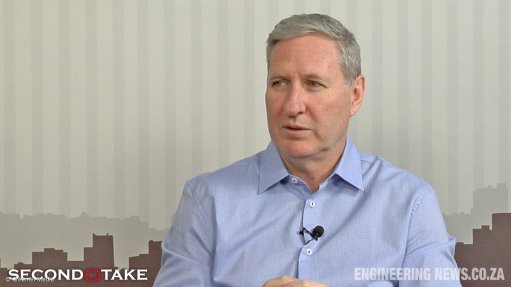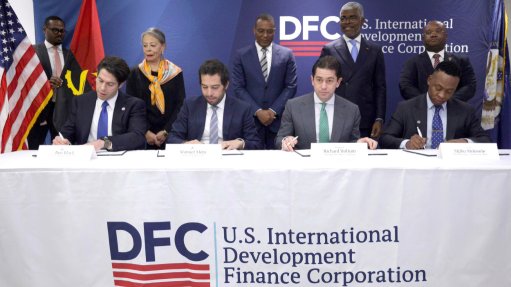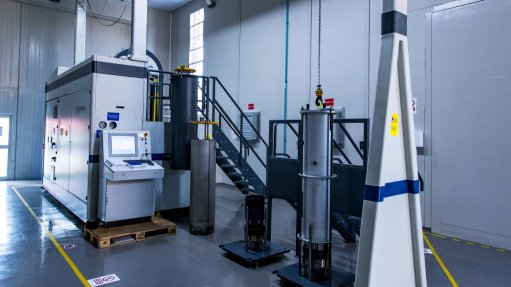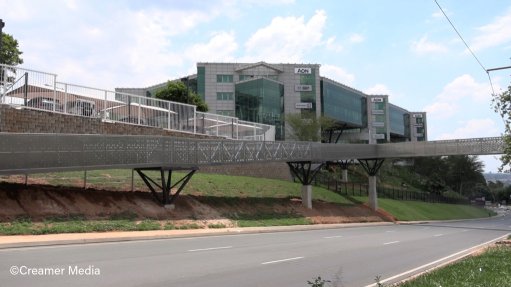Standard Bank agriculture expert says now is the time for tangible AfCFTA progress
The increasing trade turmoil globally has emphasised the need and urgency to capture the intra-Africa trade opportunity that is the African Continental Free Trade Area (AfCFTA), Standard Bank agribusiness head Louis van Ravesteyn tells Engineering News in an exclusive interview.
Although the AfCFTA Agreement is still very much in development and discussion stage between governments, it will undoubtedly have a major impact on how African countries trade, including agricultural commodities, across the continent.
Once fully implemented, the agreement will reduce barriers to trade, open new markets and facilitate regional integration, including in the agriculture sector, Van Ravesteyn highlights.
He mentions that red tape and long queues to move goods across countries have hampered the continent’s ability to become more food secure and have often resulted in higher food waste.
While over 40% of South Africa’s exports are going into African countries, Van Ravesteyn says the biggest challenges to increasing intra-regional trade are the lack of logistics infrastructure and the lack of cold chain storage.
“There is a lot of focus and investment going into logistics and cold chain capabilities, but we need more, across the continent. Standard Bank often supports these kind of infrastructure developments, including silos and warehouses,” he states.
South Africa typically exports fruit, wine, grains, beef and vegetables across Africa.
He stresses the need for more trade within the continent to ensure African countries are resilient to global shocks; however, he maintains that the US market is an important one to retain, particularly for table grapes, wine, nuts and citrus.
Van Ravesteyn hopes that meetings between the US and South African delegates in coming weeks will realise reduced trade barriers or even a “new agreement” between the two regions.
Likewise, it is important to leverage China’s agricultural import diversification strategy for African producers, he adds, with China being one of the largest importers of agricultural produce in the world.
Van Ravesteyn points out that China favours investing in African agriculture owing to its fertile soil, labour affordability, ample sunshine and regular rains – in most countries.
“China is an open, big market, hence the importance of getting protocols approved between governments.”
Again, Standard Bank often helps in this regard owing to its close relationship with Chinese investors and companies. The bank has dedicated partners and facilitators to help with the cultural and language barriers between African countries and China.
“We have a whole trade solution between Africa and China to assist customers with moving more products into that market and garner more foreign currency earnings,” Van Ravesteyn says, citing examples of trade expos that Standard Bank often uses as platforms to connect African producers with Chinese offtakers.
These connection-building and information-sharing platforms are becoming increasingly valuable in the agriculture sector, as the world tries to forge new trade alliances and open more markets.
Van Ravesteyn explains how the recent Nampo agriculture show in Bothaville, in the Free State, has grown to bring 20 000 to 30 000 people a day together from the region as well as key stakeholders and original-equipment manufacturers from all over the world to discuss innovation in genetics and cultivars, technology advancements and sustainability.
He mentions that Standard Bank often aids with showcasing South Africa’s solid commercial agriculture capabilities and, likewise, connecting South African producers with other stakeholders across the continent to expose them to developments in agriculture value chains elsewhere.
For Van Ravesteyn, Nampo has become more of a global event, with involvement from countries as far afield as Brazil and Argentina, with growing interest in investing in African agriculture or enabling more trade.
“Local farmers are realising they have a wider impact in the country and the continent as a region in improving food security. For example, showing how Nigeria has grown its primary agriculture sector to be four to five times the size of that of South Africa’s primary agriculture sector shows that countries have much to learn from each other.”
Another important platform for advancing Africa’s agriculture story is South Africa’s G20 presidency this year, which Van Ravesteyn says has enabled more foreign countries to visit the continent and see what it has to offer.
Apart from increased knowledge-sharing globally and advancing intra-regional trade, Van Ravesteyn also emphasises the importance of supporting small-scale farmers.
“While South Africa has 80% to 90% of its produce produced by commercial farmers and other African countries generally have the opposite feature of small-scale growers contributing the majority of produce, both situations offer scope for small-scale grower support through various models.”
He explains that Standard Bank strives to have a deep understanding of small-scale farmer needs and how they play a role across the value chain. The bank has various upskilling initiatives and enterprise development programmes to help farmers become more profitable and understand financial management of their business.
One such initiative, called One Farm Share in South Africa focuses on food waste reduction and food relief for vulnerable communities, as well as assisting farmers with market access. Van Ravesteyn stresses how financial institutions have become increasingly involved with developing entire value chains, not just investing in singular assets.
Another initiative, called One Farm Grow, has helped digitise the agriculture value chain in Kenya, with Standard Bank having worked with input providers and commercial offtakers to strengthen and modernise the agriculture value chain.
In cases where Standard Bank does not work directly with farmers and offtakers to develop value chains, the bank often supports offtakers in order to support small-scale farmers along the line. “There are different models to develop value chains,” Van Ravesteyn points out.
In conclusion, he says the next five years will be critical in shaping the AfCFTA to deliver tangible benefits to African countries and enable more free trade. “We encourage government and industry players in discussions to come up with practical low-hanging fruit solutions to get things going.”
Article Enquiry
Email Article
Save Article
Feedback
To advertise email advertising@creamermedia.co.za or click here
Comments
Press Office
Announcements
What's On
Subscribe to improve your user experience...
Option 1 (equivalent of R125 a month):
Receive a weekly copy of Creamer Media's Engineering News & Mining Weekly magazine
(print copy for those in South Africa and e-magazine for those outside of South Africa)
Receive daily email newsletters
Access to full search results
Access archive of magazine back copies
Access to Projects in Progress
Access to ONE Research Report of your choice in PDF format
Option 2 (equivalent of R375 a month):
All benefits from Option 1
PLUS
Access to Creamer Media's Research Channel Africa for ALL Research Reports, in PDF format, on various industrial and mining sectors
including Electricity; Water; Energy Transition; Hydrogen; Roads, Rail and Ports; Coal; Gold; Platinum; Battery Metals; etc.
Already a subscriber?
Forgotten your password?
Receive weekly copy of Creamer Media's Engineering News & Mining Weekly magazine (print copy for those in South Africa and e-magazine for those outside of South Africa)
➕
Recieve daily email newsletters
➕
Access to full search results
➕
Access archive of magazine back copies
➕
Access to Projects in Progress
➕
Access to ONE Research Report of your choice in PDF format
RESEARCH CHANNEL AFRICA
R4500 (equivalent of R375 a month)
SUBSCRIBEAll benefits from Option 1
➕
Access to Creamer Media's Research Channel Africa for ALL Research Reports on various industrial and mining sectors, in PDF format, including on:
Electricity
➕
Water
➕
Energy Transition
➕
Hydrogen
➕
Roads, Rail and Ports
➕
Coal
➕
Gold
➕
Platinum
➕
Battery Metals
➕
etc.
Receive all benefits from Option 1 or Option 2 delivered to numerous people at your company
➕
Multiple User names and Passwords for simultaneous log-ins
➕
Intranet integration access to all in your organisation



















